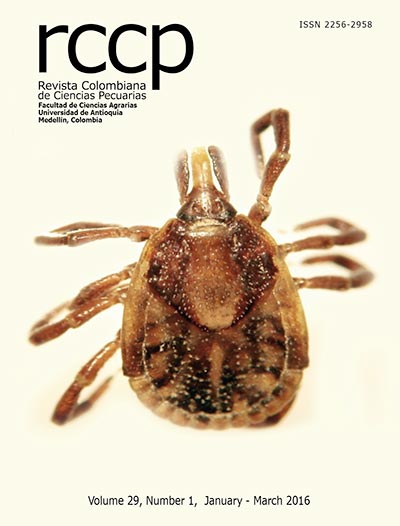Resistencia de tres poblaciones de Rhipicephalus microplus a la ivermectina por el ensayo de inmersión de larvas
DOI:
https://doi.org/10.17533/udea.rccp.324964Palabras clave:
garrapatas, actonas macrocíclicas, pérdida de eficaciaResumen
en Colombia, el control de la infestación de garrapatas en el ganado se ha realizado casi exclusivamente con acaricidas químicos y es importante determinar el grado de resistencia de las poblaciones de campo de Riphicephalus microplus a ivermectinas (IVM) como el primer paso para diseñar tácticas que aumenten su vida útil y disminuyan la dependencia de los controles químicos. Objetivo: probar el grado de resistencia a IVM. Métodos: se evaluó la resistencia de R. microplus a IVM en tres fincas ganaderas en Antioquia (Colombia) donde se sospechaba que productos con IVM estaban fracasando para controlar infestaciones por garrapatas. Se recolectaron garrapatas con varios meses de diferencia durante el año 2013 y se empleó la prueba de inmersión de larvas (LIT) con la descendencia de las hembras adultas. Los datos de concentraciónmortalidad fueron sometidos a análisis probit. Resultados: los resultados para las tres poblaciones estudiadas mostraron concentraciones letales (LC) 50 y 99 de ≥ 30 ppm y ≥ 400 ppm, respectivamente. No se observó diferencia en las LC obtenidas en diferentes momentos de recogida para cada población estudiada. Los altos valores de LC, junto con pendientes muy bajas en las rectas de regresión (≤ 2), indicaron una respuesta muy heterogénea a concentraciones crecientes de IVM, propio de poblaciones resistentes. En dos de las granjas, la administración de inyecciones subcutáneas con una formulación de acción prolongada de la IVM a dosis de 630 μg/Kg fue incapaz de eliminar las infestaciones y proteger frente a reinfestaciones, confirmando las sospechas de los ganaderos de pérdida de eficacia. Conclusión: estudios epidemiológicos son necesarios para evaluar el estado actual de la resistencia a IVM en esta región de Colombia, y es probable que el uso intensivo de IVM agrave esta situación en el futuro.
Descargas
Citas
Arieta Román RJ, Rodriguez Vivas RI, Rosado Aguilar JA, Ramirez Cruz GT, Basto Estrella G. Persistent efficacy of two macrocyclic lactones against natural Rhipiceplalus (Boophilus) microplus infestations in cattle in the Mexican tropics. Rev Mex Cienc Pecu 2010; 1: 59-67. Castro Janer E, Rifran L, Gonzalez P, Niell C, Piaggio J, Gil A, Schumaker TTS. Determination of the susceptibility of Rhipicephalus (Boophilus) microplus (Acari: Ixodidae) to ivermectin and fipronil by larval immersion test (LIT) in Uruguay. Vet Parasitol 2011; 178:148-55. Davey RB, Pound JM, Miller JA, Klavons JA. Therapeutic and persistent efficacy of a long-acting (LA) formulation of ivermectin against Rhipicephalus (Boophilus) microplus (Acari: Ixodidae) and será concentration through time in treated cattle. Vet Parasitol 2010; 169:149-56.FAO. Working Group on Parasite Resistance. “Acaricide resistance: diagnosis, management and prevention”, in Guidelines Resistance Management and Integrated Parasite Control in Ruminants 2004, pp. 25-77. Fernández Salas A, Rodríguez Vivas RI, Alonso Diaz MA, Basurto Camberos H. Ivermectin resistance status and factors associated in Rhipicephalus microplus (Acari:Ixodidae) populations from Veracruz, Mexico. Vet Parasitol 2012; 190:210-5.García Paz JL. Evaluación de las propiedades acaricidas de Piper crassinervium Kunth. Piper aequale Vahl. (Piperaceae) sobre larvas de Rhipicephalus (Boophilus) microplus. Trabajo de grado para optar a título de maestría. Universidad Nacional. Colombia. 2011Grise L, Leite RC, Martins JR, Barros AT, Andreotti R, Perez de Leon AA, Pereira JC, Silva H. Reassessment of the potential economic impact of cattle parasites in Brazil. Braz J Vet Parasitol Jaboticabal 2014; 23(2):150-6.Holdsworth PA, Kemp D, Green P, Peter RJ, De Bruin C, Jonsson NN, Letonja T, Rehbein S, Vercruysse J. World Association for the Advancement of Veterinary Parasitology (W.A.A.V.P.) guidelines for evaluating the efficacy of acaricides against ticks (Ixodidae) on ruminants. Vet Parasitol 2006; 136:29-43.Klafke GM, Sabatini GA, Albuquerque TA, Martins JR, Kemp DH, Miller RJ, Schumaker TTS. Larval immersion tests with ivermectin in populations of the cattle tick Rhipicephalus (Boophilus) microplus (Acari: Ixodidae) from State of Sao Paulo, Brazil. Vet Parasitol 2006; 142:386-90.Klafke GM, Albuquerque TA, Miller RJ, Schumaker TTS. Selection of an ivermectin-resistant strain of Rhipicephalus microplus (Acari: Ixodidae) in Brazil. Vet Parasitol 2010; 168:97-104.
Klafke GM, Castro Janer E, Mendes MC, Namindome A, Schumaker TTS. Applicability of in vitro bioassays for the diagnosis of ivermectin resistance in Rhipicephalus microplus(Acari: Ixodidae). Vet Parasitol 2012; 184:121-220. López Arias A, Villar D, Miller R, Chaparro J, Pérez de león, A. Reduced efficacy of commercial acaricides against populations of resistant cattle tick Rhipicephalus microplus from two municipalities of Antioquia, Colombia. Libertas Académica, 2015 (in press).Martins JR, Furlong J. Ivermectin resistance of the cattle tick Boophilus microplus in Brazil. Vet Rec 2001; 149:64.Pérez Cogollo LC, Rodríguez Vivas RI, Ramírez Cruz GT, Rosado-Aguilar JA. Survey of Rhipicephalus microplus resistance to ivermectin at cattle farms with history of macrocyclic lactones use in Yucatan, Mexico. Vet Parasitol 2010a; 172:109-113. Pérez Cogollo LC, Rodríguez Vivas RI, Ramírez Cruz GT, Miller RJ. First report of the cattle tick Rhipicephalus microplus resistant to ivermectin in Mexico. Vet Parasitol 2010b; 168:165-9.Sabatini GA, Kemp DH, Hughes S, Nari A, Hansen J. Tests to determine LC50 and discriminating doses for macrocyclic lactones against the cattle tick, Boophilus microplus. Vet Parasitol 2001; 95(1):53-62.
Descargas
Publicado
Cómo citar
Número
Sección
Licencia
Derechos de autor 2016 Revista Colombiana de Ciencias Pecuarias

Esta obra está bajo una licencia internacional Creative Commons Atribución-NoComercial-CompartirIgual 4.0.
Los autores permiten a RCCP reimprimir el material publicado en él.
La revista permite que los autores tengan los derechos de autor sin restricciones, y permitirá que los autores conserven los derechos de publicación sin restricciones.






